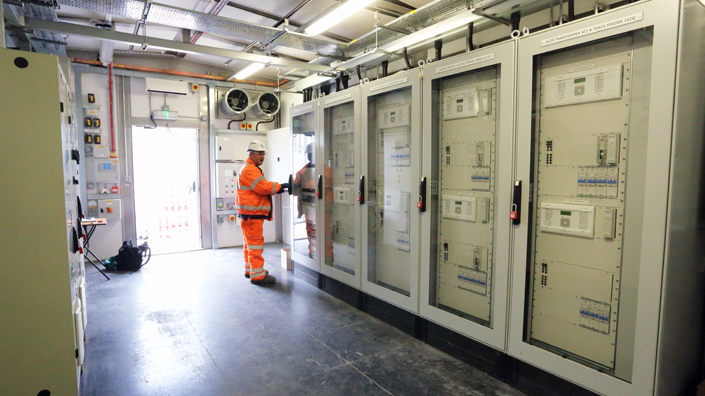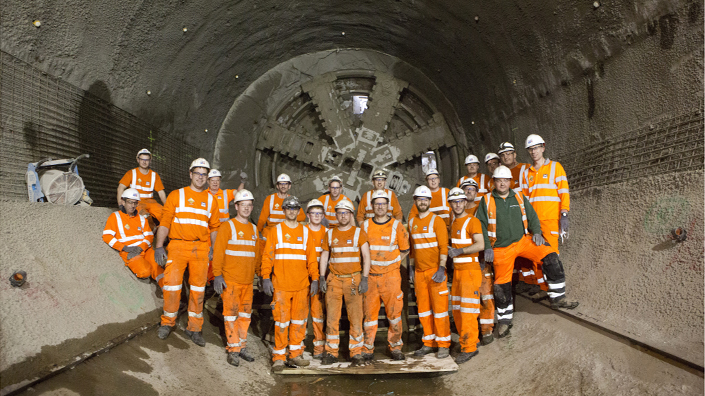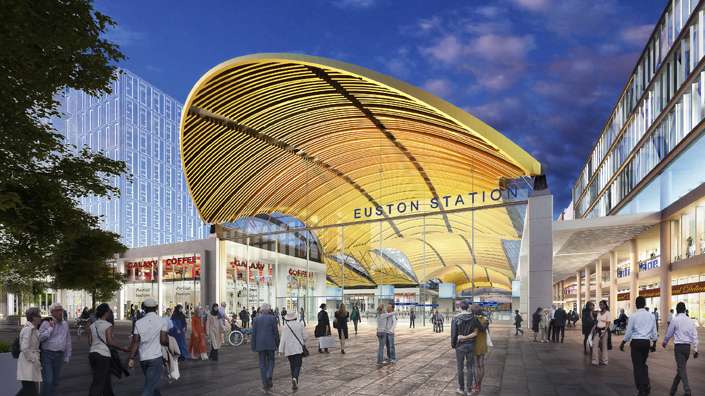Britain is going through a railway renaissance. From the rebirth of London St Pancras as the home of Eurostar to the £750m transformation of Birmingham New Street, money is pouring into the rail network to accommodate 1.7bn passenger journeys annually – twice as many as in 1997.
Most recently, London Bridge Station reopened following a complete rebuild and realignment of its platforms to boost capacity by 30%. We are now less than a year away from Crossrail – or the Elizabeth Line as it will be known – running east-west through new tunnels under the capital. This £14.8bn project will boost central London’s rail capacity by 10%. Work has also started on High Speed 2, which is set to begin services in 2026 and has an estimated total cost of £56bn.
What is significant about these projects is not just the eye-watering costs, or the added capacity – they are also using Internet of Things technologies to make the railways function more effectively and efficiently than ever.
Data on track
Compared to fractured control systems from 10-15 years ago, the Crossrail Data Network is built from the ground up, with pretty much every component – from ventilation control to the desktop PCs in the office – working on the same fibre backbone. Even voice traffic and CCTV use it, although some capacity will remain exclusively dedicated to signalling for obvious reasons.
The upshot of this modern approach is simple – all of the data collected can easily be fed to a central network management centre, where data from the entire network is displayed together on a dashboard so the railway can be managed more effectively, and data analysed more easily.
So what efficiencies can be gained? The most immediate upshot of all of this data-wrangling is that it transforms the way that maintenance happens – it could see the industry shift from calendar- or kilometre-based maintenance to only intervening when systems say a given component (or ‘asset’) requires it. This would not simply be sensors spotting components malfunctioning, but could actually be preventative. By using data collected on the component previously, and other components like it, systems can actively predict when work is needed.

An engineer inspects a Crossrail control room (Credit: Crossrail)
This new predictive maintenance could be a huge deal, given the massive number of assets required in running a railway. Perhaps it could even help limit weekend engineering works and mitigate that notorious commuter frustration – leaves on the line.
River Tamoor Baig is the co-founder of Hacktrain, a conference and “hackathon” challenging the rail industry to be smarter with its data. He thinks a company called Optasense offers the perfect example of how this works. The Farnborough company puts acoustic sensors along tracks, which then detect changes in the surroundings.
“What these sensors do is they pick up rocks falling off into the tunnels or they pick up the tracks degrading – they can then report right back to Network Rail,” he explains. “Right now what Network Rail does is every six months they will look at a tunnel and find out how many rocks there are and pick them all up – whereas the sensors are all about responding to incidents as they happen.”
Although it is early days for this sort of maintenance, the UK is taking some tentative steps. On Crossrail, vibration sensors on the fans circulating air in the tunnels will look for early warning signs of bearing fatigue, and water levels in every ditch beneath the track will be monitored to ensure that pumps are performing as expected.

Workers stand in a Crossrail tunnel (Credit: Crossrail)
Bosses at HS2 are planning similar installations. “Points systems are affected by weather, so whether it’s hot or cold, whatever location they’re in, whether they’re in cuttings or tunnels, there’s a whole plethora of different datasets that would assist us,” says David White, head of asset management and strategic planning for the new railway.
The closest analogy at the moment is Rolls-Royce aircraft engines packed with thousands of sensors, says White. He hopes this sort of detailed monitoring can be adapted for the railways.
It isn’t all about the track, though – smart sensors are also making their way into trains. Alstom is the company responsible for building and maintaining many of the trains on Britain’s railways, including Virgin’s Pendolino fleet, and, although its vehicles do not have truly connected components yet, it is already using smart sensors to monitor on-train assets. Each night when trains return to their depots, they pass through automatic car-wash-style systems that measure crucial data. On-board sensors also report back if on-board assets are or will be in need of maintenance.
It is easy to imagine a future iteration of this same capability where sensors report back while the train is at work, so maintenance teams at the depot can be prepared when it arrives.
The benefits of this more dynamic and data-driven approach are clear, says Philippe Dume, digital transformation director at Alstom. He thinks there could be profound consequences: “Once we have dynamic maintenance it means dynamic planning in the depot, it means dynamic testing… you’re completely changing how things are done.”
Victorian hold-ups
All of this new technology sounds brilliant – but how soon can it be adopted more widely? Unfortunately, the UK has a major disadvantage – railways were invented here 200 years ago, and centuries of development has left more legacy equipment than in other countries.
“We’re probably the worst in the entire world because our railway is the oldest,” says Baig. “It’s even harder for us to be able to manage the infrastructure that we have. In other countries like Hong Kong, China or even Canada, where the railways are much newer, it is a different ballgame for them. They’re not working with infrastructure that’s 100-150 years old.”
The other limiting factor is that railways are subject to technological standards that have been set in stone and are updated more slowly than in other industries, explains Crossrail’s chief engineer Chris Binns. Take 5G internet, for example – when it launches around 2020, it is expected to offer faster download speeds and much lower latency. But Binns believes it will be tricky to take advantage of the latest mobile data technologies, because the UK railway network is locked into standards set out by the European Train Control System. This system runs on a rail-specific network known as GSM-R, a two-decades-old technology limited to running at 2G speeds.
Even Crossrail will be limited by these standards. Although the tunnels and infrastructure under London are entirely new, once the trains head above ground and use national rail tracks to reach Reading and Heathrow, trains will also have to use the GSM-R system.
The other challenge is one of regulation. According to Alstom’s Dume, the time needed to persuade governments to change safety rules to enable dynamic maintenance, for example, can reduce the speed at which new technologies can be rolled out.
Things will have to change. In the view of White from HS2, technology is speeding up the pace of change – previously, signalling systems may have had an expected 50-year lifecycle, but now this could be reduced to 25 years or fewer. “In 10 years’ time those routers will be pretty old and those switches won’t be made by anyone – Cisco might not support that technology any more,” he says as an example. This could completely transform how railways are planned and designed, as bulk investments on new kit may need to be re-examined for shorter shelf lives.

A concept image shows how the London Euston HS2 station could look (Credit: HS2/ Grimshaw)
But, even given these changes, White thinks these new technologies will still be adopted – and, as long as modern railways are built as open systems, software on new platforms that don’t exist yet will still be able to work with systems and sensors that are installed today.
New business models
It is clear that Britain’s railways are becoming increasingly connected. All components on railways such as Crossrail and HS2 will essentially be nodes on a network, and with this will not just come greater efficiency – Binns believes it could completely transform how the industry works at a fundamental level, changing the current franchising business model into something more sophisticated.
With every aspect of the railway under realtime control and with every asset connected via an IP network, authorities such as Network Rail or Transport for London could instead act more like Amazon AWS or Microsoft Azure, he says – a platform.
Rail authorities might simply crunch the data to ensure trains are routed safely, and then maintenance and control of all the assets on a rail network could be contracted out more fluidly. All a rail authority would have to do is essentially provide a company with a set of access keys to the realtime sensor and maintenance data, meaning it should be possible to switch contractors more easily.
Why does this matter? Ultimately, whether or not Binns’ dream ever becomes a reality, the incentives are clear – by aiming at a future where every component is simply a node on an IP network, the railways can become more efficient, trains can become cheaper to run and assets will be more reliable. And that means that everyone – including the passengers – will benefit.
Content published by Professional Engineering does not necessarily represent the views of the Institution of Mechanical Engineers.